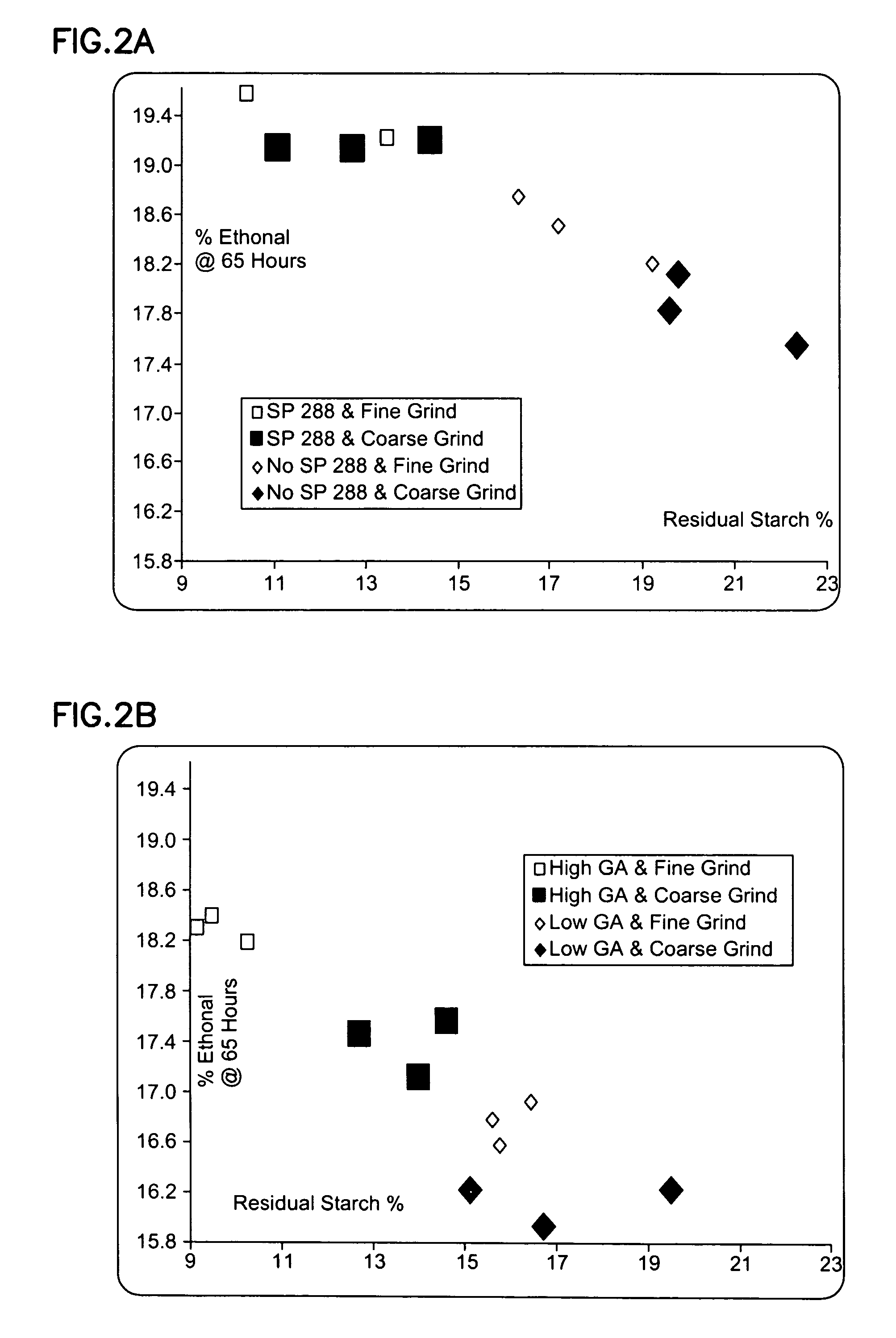Methods and systems for producing ethanol using raw starch and selecting plant material
a technology of raw starch and plant material, which is applied in the field of methods and systems for producing ethanol using raw starch and selecting plant material, can solve the problems of numerous inefficiencies in the methods, and achieve the effect of high alcohol content and beer production
- Summary
- Abstract
- Description
- Claims
- Application Information
AI Technical Summary
Benefits of technology
Problems solved by technology
Method used
Image
Examples
example 1
Production of Improved Distiller's Dried Grain from Corn
[0176]A method according to the present invention was employed to produce distiller's dried grain from corn. This method produced high protein, high fat, and high fiber distiller's dried grain. Comparison with a conventional saccharification and liquefaction process indicates superior performance of the present method.
Materials and Methods
Raw Starch Fermentation
[0177]Yeast inoculum was prepared by adding glucoamylase (0.088 ml of Novozymes' Spirizyme Plus gluco-amylase at 400 AGU / g) and protease (0.018 ml of Genencor International's GC 106 protease 1000 SAPU / g) to 400 ml of stillage containing 70 grams of maltodextrin. Stillage (backset) used was prepared from prior conventional or raw starch fermentations by distilling off the alcohol and subjecting the resulting whole stillage to centrifugal separation to produce backset. 1.07 grams of urea, 0.13 grams of zinc sulfate, and 0.00067 ml of a 1:1000 dilution of Antibiotic (Alltec...
example 2
The Present Process Provides Improved Yield Potential
[0191]The yield potential of the method of the present invention was compared to a conventional process. The present method exhibited improved yield using temperature staging. The present method exhibited an increased potential maximum yield for ethanol production. Comparison with conventional saccharification and liquefaction process indicates superior performance of the present method.
Materials and Methods
[0192]Fermentations were prepared in a similar manner as in Example 1 except for intentional differences in particle size, alpha amylase enzyme dose, gluco-amylase enzyme dose, or acid fungal amylase enzyme dose. Conditions for this experiment are described in Table 4. Corn for all tests was obtained from Broin Enterprises (BEI), Scotland, S. Dak., USA. Corn representing a coarse particle size by raw starch standards was ground at BEI. Finely ground corn was produced using a lab hammer mill through a 0.5 mm screen.
[0193]The con...
example 3
Impact of Grind Particle Size, Glucoamylase Type, and Acid Fungal Amylase Dosage on Fermentation Efficiency
[0198]Results of an embodiment of the method of the present invention were evaluated with varying particle size of the ground plant material, varying glucoamylase type, and dosage of acid fungal amylase.
Materials and Methods
[0199]Whole Corn and corn flour was obtained from Dakota Ethanol LLC in Wentworth, S. Dak. The whole corn was ground through a 2.0 mm screen as in prior examples using a lab scale hammer mill. Fermentations were set up in a similar manner as prior Examples according to the outline in Table 5.
[0200]
TABLE 5Impact of Grind Particle Size, Glucoamylase Type, andAcid Fungal Amylase Dosage on Fermentation EfficiencySieve SizeScreenNo. 12No. 16No. 20No. 25No. 30No. 35PanPore Size (mm)Size (mm)1.701.180.850.710.600.502.0 mm0.00.21.43.23.615.373.0“Finer Grind”Plant Hammer mill #710.218.914.07.43.87.938.1“Coarser Grind“Experimental Outline for Example 5AFAU Dose Per Gr...
PUM
| Property | Measurement | Unit |
|---|---|---|
| pH | aaaaa | aaaaa |
| temperature | aaaaa | aaaaa |
| temperature | aaaaa | aaaaa |
Abstract
Description
Claims
Application Information
 Login to View More
Login to View More - R&D
- Intellectual Property
- Life Sciences
- Materials
- Tech Scout
- Unparalleled Data Quality
- Higher Quality Content
- 60% Fewer Hallucinations
Browse by: Latest US Patents, China's latest patents, Technical Efficacy Thesaurus, Application Domain, Technology Topic, Popular Technical Reports.
© 2025 PatSnap. All rights reserved.Legal|Privacy policy|Modern Slavery Act Transparency Statement|Sitemap|About US| Contact US: help@patsnap.com



